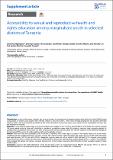| dc.contributor.author | Ngilangwa, David Paul | |
| dc.contributor.author | Rajesh, Sharanya | |
| dc.contributor.author | Kawala, Mercy | |
| dc.contributor.author | Mbeba, Rita | |
| dc.contributor.author | Sambili, Benatus | |
| dc.contributor.author | Mkuwa, Serafina | |
| dc.contributor.author | Noronha, Rita | |
| dc.contributor.author | Meremo, Alfred Jackson | |
| dc.contributor.author | Nyagero, Josephat | |
| dc.date.accessioned | 2021-08-21T12:09:22Z | |
| dc.date.available | 2021-08-21T12:09:22Z | |
| dc.date.issued | 11/26/2016 | |
| dc.identifier.citation | David Paul Ngilangwa et al. Accessibility to sexual and reproductive health and rights education among marginalized youth in selected districts of Tanzania. Pan African Medical Journal. 2016;25(2):2. [doi: 10.11604/pamj.supp.2016.25.2.10922] | en_US |
| dc.identifier.issn | 1937-8688 | |
| dc.identifier.uri | http://repository.amref.org/handle/123456789/122 | |
| dc.description | � David Paul Ngilangwa et al. The Pan African Medical Journal - ISSN 1937-8688. This is an Open Access article distributed under the terms of the Creative Commons
Attribution License (http://creativecommons.org/licenses/by/2.0), which permits unrestricted use, distribution, and reproduction in any medium, provided the
original work is properly cited.) | en_US |
| dc.description.abstract | Introduction: access to information, education and services is central in the promotion of sexual and reproductive health and rights (SRHR) among
young people. It enables young people make informed choices on sexuality matters, hence reduce teenage pregnancies and sexually transmitted
infections (STIs). This study assessed accessibility of SRH rights’ information among marginalized young people in three municipalities of Iringa, Ilala
and Kinondoni in Tanzania.
Methods: a cross-sectional study design using mixed methods was conducted in 2013 in three selected districts of Tanzania. We randomly selected
398 young people including those with disabilities to partake in quantitative survey while 48 community members were purposely selected for
qualitative part. Quantitative data analysis was done using descriptive statistics and chi square test with the assistance of the Statistical Package for
Social Science(SPSS) version 20, while qualitative data was thematically analyzed.
Results: there were 396 (99%) participants (144 Males and 251 females), with a mean age of 20.1years. The majority were out of school female,
cohabiting and had completed secondary education. Overall, 317 (79.6%) had SRH rights knowledge. The leading sources of SRH rights information
were peer educators (36.7%) and radio (22.8%). Awareness regarding laws and policies related to SRH right was 55.1%. However, young people
living with HIV and school truants had more access to SRHR education and services than the other youth groups(χ2 30.69, p< 0.0001). The qualitative
study revealed that parents and teachers perceived themselves to be incompetent in providing SRH information to their youngsters despite of being
mostly trusted.
Conclusion: access to SRH rights information is high but decreases when it is disaggregated across different age groups. There is a need for
diversified approach for reaching specific groups of young people depending on their needs and circumstances | en_US |
| dc.description.sponsorship | Swedish International Development Agency (SIDA) funding this study as part of TUITETEE project | en_US |
| dc.language.iso | en | en_US |
| dc.publisher | Pan African Medical Journal | en_US |
| dc.subject | Marginalized youths | en_US |
| dc.subject | Access | en_US |
| dc.subject | SRHR | en_US |
| dc.subject | School dropout | en_US |
| dc.subject | Tanzania | en_US |
| dc.title | Accessibility to Sexual and Reproductive Health and Rights Education Among Marginalized Youth in Selected Districts of Tanzania | en_US |
| dc.type | Article, Journal | en_US |

